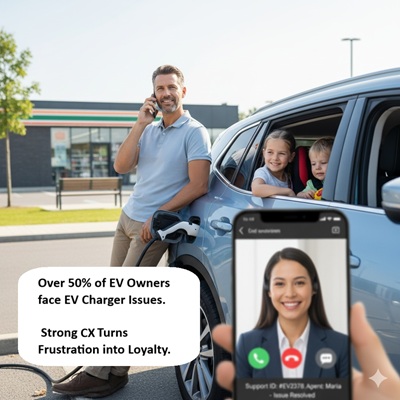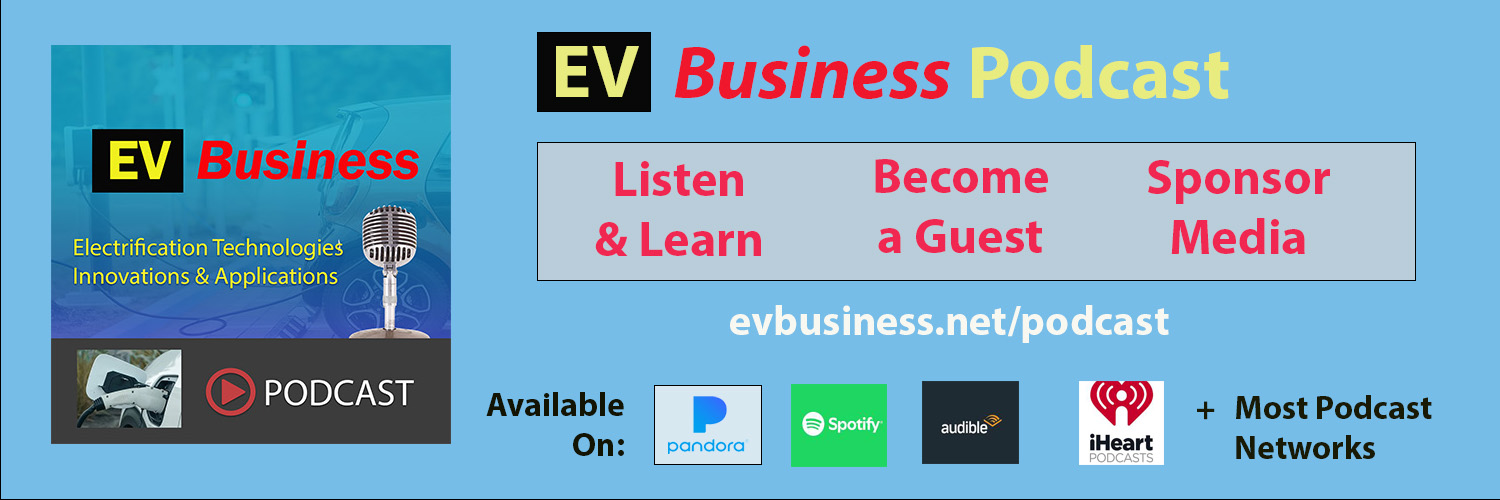By: Omar Riahi
EV companies need to provide customer service that is efficient, personalized, and capable of supporting both technical and non-technical users to maintain high satisfaction. Nearly 50% of EV drivers face issues with EV chargers—such as malfunctions, payment errors, or inactive stations—resulting in frequent support calls and highlighting the value of well-trained service teams in building trust. Customer support demands can be complex, with users expecting real-time solutions, while measuring ROI remains challenging. This article explores strategies to boost customer satisfaction, lower costs, and uncover new revenue opportunities.

You want to discover more about EV Customer Experience? Listen to the podcast session that this article summarizes – EVBusiness.net/110. Also available on Spotify, Pandora, Audible, iHeartRadio & other podcast networks.
Electric vehicles (EVs) are reshaping the automotive industry, but the true differentiator is no longer just performance or range—it’s the customer experience (CX). Delivering efficient, personalized, and reliable support is critical not only to keep customers satisfied but also to secure loyalty in a rapidly expanding market.
As EV adoption accelerates, especially in regions like Norway where EV penetration is nearing 97%, automakers, charging operators, and fleet providers must recognize that customer experience is as important as vehicle design. At Percepta, I lead efforts to help companies streamline customer journeys, reduce costs, and uncover new value through data-driven CX strategies.
Defining EV Customer Experience (CX)
EV customer experience encompasses every interaction: home charging, public charging, software subscriptions, telematics, and vehicle service. The goal is simple—remove pain points and reduce cycle time. Automating tasks like account lookups, email notifications, or billing ensures faster resolution and eliminates repetitive customer interactions. The result is a one-stop, frictionless experience that builds trust.
Why EV Customer Experience Matters
CX is not a “nice-to-have”—it is essential. Dissatisfied customers switch brands 52% of the time after a single poor experience. Well-executed EV CX strategies reduce support costs, strengthen brand loyalty, and create lifetime value. In fact, by mapping the full customer lifecycle—from pre-sales onboarding to proactive service reminders and loyalty programs—automotive companies can retain customers and guide them seamlessly into their next EV purchase.
Key Industries That Need EV CX Solutions
Automotive OEMs, charging network operators, private charging providers, fleet managers, and telematics companies all face unique customer experience (CX) challenges in the EV ecosystem. Each group must ensure seamless service delivery—whether that’s supporting EV buyers, reducing charging frustrations, managing tenant billing, keeping fleets on the road, or simplifying connected data services. By optimizing CX across these segments, companies can build loyalty, improve efficiency, and unlock new revenue opportunities in a rapidly growing market.
Automotive OEMs: Require CX optimization to support EV buyers, strengthen loyalty, and drive repeat sales.
Charging Network Operators: Must deliver frictionless support for users facing real-time charging challenges.
Private EV Charging Operators: Depend on streamlined CX tools to manage tenant access, billing accuracy, and service reliability across diverse property types.
Fleet Operators: Need scalable CX processes to manage large driver bases and minimize downtime.
Telematics Providers: Rely on CX strategies to simplify data-driven services and keep users engaged.
How EV CX Optimization Works
The process begins with assessing the customer journey—identifying pain points and opportunities for improvement. Next comes upskilling staff to understand both EV products and customer expectations. Finally, we apply automation and integration, connecting telephony, CRM, and billing systems to deliver seamless support. This dual approach reduces operating expenses while increasing revenue and customer satisfaction.
Strategic Changes Needed for CX Transformation
Successful implementation of EV customer experience improvements demands a balance of technology and cultural change. Companies need to map the full customer journey, streamline interactions, and use automation to deliver faster, more consistent support. At the same time, educating both customers and dealers helps close knowledge gaps and build long-term confidence in EV adoption. Companies must:
Map the end-to-end customer journey and identify friction points.
Simplify interactions by removing redundancies and reducing customer effort.
Leverage automation to speed up response times and improve consistency.
Educate customers and dealers on EV technology to bridge knowledge gaps.
Features and Capabilities of Strong EV CX Programs
Strong EV customer experience (CX) programs combine seamless support, education, and data-driven service. They integrate home and public charging, assist with software and subscription features, and proactively address customer needs through insights and loyalty initiatives. An upskilled workforce ensures customers feel confident and supported throughout their EV journey. Scalable CX models that grow with EV adoption have these key features and capabilities:
Integrated Home and Public Charging Support
Subscription and Software Feature Assistance
Comprehensive Customer Education to close knowledge gaps
Advanced Data-Driven Insights for proactive support and loyalty programs
Upskilled Workforce that understands EV technology and customer needs
Implementation Tips for EV CX
When implementing EV customer experience CX, you should listen closely to feedback, design journeys before layering in technology, and pilot changes in small, measurable steps. This approach builds trust, demonstrates ROI early, and secures buy-in across the organization.
Listen to customer feedback—it provides a direct roadmap for CX design.
Design journeys first, then apply technology—as Steve Jobs once said, “Start with the customer experience and work back to the technology.”
Pilot improvements incrementally, showing ROI early to gain organizational buy-in.
The Future of EV CX
The U.S. EV market is still maturing, and many companies prioritize CapEx on production rather than CX. However, as adoption rises, CX will become the differentiator. Companies that invest now in customer support, automation, and proactive engagement will accelerate revenue growth and build stronger long-term relationships.
At Percepta, we believe elevating the customer experience is the foundation for success in this new automotive era. As our president Karen says, “Elevating the customer experience is the call to action behind everything we do.”

About Omar Riahi
Omar Riahi is the EV Customer Experience – CX Optimization leader at Percepta, specializing in innovative customer support strategies for the EV industry. With over 15 years of expertise in customer service operations, process optimization, and EV support technologies, Omar has driven initiatives that enhance satisfaction, streamline workflows, and reduce costs. A Lean Six Sigma Black Belt, he is known for implementing data-driven solutions that elevate EV customer experiences while creating new value for automotive clients.


